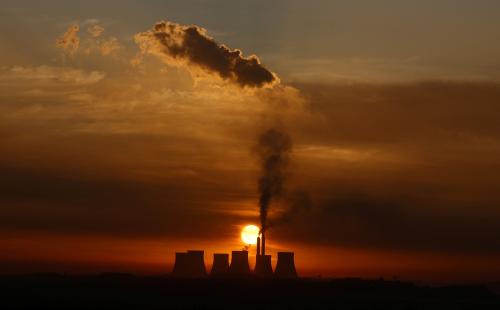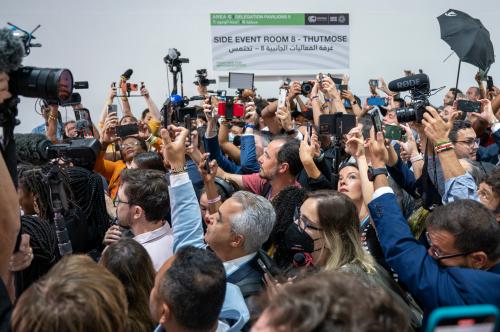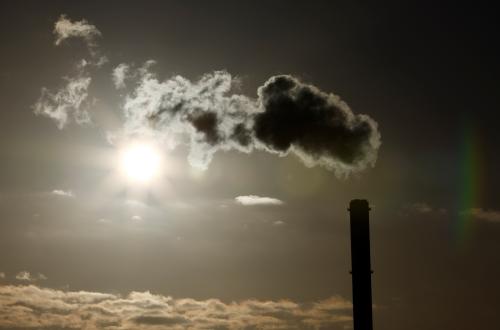Samantha Gross, director of the Energy Security and Climate Initiative at Brookings, talks with David Dollar about whether we can attribute the growing number of extreme weather events and disasters to climate change. Gross says global temperature rise makes these events more likely, but also notes that international cooperation to reduce carbon is having a positive effect on average temperature rise.
- Listen to Dollar & Sense on Apple, Spotify, Google, or wherever you like to get podcasts.
- Learn about other Brookings podcasts from the Brookings Podcast Network.
- Sign up for the podcasts newsletter for occasional updates on featured episodes and new shows.
- Send feedback email to [email protected].
TRANSCRIPT
[music]
DOLLAR: Hi, I’m David Dollar, host of the Brookings trade podcast Dollar and Sense. It seems that we’re witnessing an endless series of climate disasters around the world, from heat waves to wildfires to torrential rains and flooding. So, climate change is our very appropriate topic today, and my guest is Samantha Gross, director of Brookings’s Energy Security and Climate Initiative. So welcome to the show, Samantha.
GROSS: Thanks, David. It’s always good to be here.
DOLLAR: So, let’s start with a survey of some of the environmental disasters that are going on around the world and ask the question, can we attribute some of these disasters or all of them to climate change?
GROSS: You know, I used to say, well, it’s hard to attribute anything that, it’s just that these events are becoming more likely. But actually the science of attributing weather events to climate change is getting better all the time. Analysis that just came out a couple of days ago found that the ongoing heat wave, for instance, in the southern U.S. and northern Mexico is about two degrees Celsius or more than three and a half degrees Fahrenheit warmer than it would have been without climate change. And so, that’s a really tangible result that you can think about.
It’s also making such events more likely. For instance, the current heat wave goes from nearly impossible without any climate change to potentially occurring every 2 to 5 years in the future if we continue on this emissions path.
So, the science of attribution is getting better and I think it enables us to really understand what we’re doing to the climate and what it means for our weather. We can just expect more energetic weather in a warmer world. Hotter heatwaves, wetter rainy spells, drier droughts. And what we’re seeing now isn’t really even the new normal. We’re changing quickly enough that there really isn’t a normal for the climate right now. We’ve not reached any kind of equilibrium.
DOLLAR: With all these disasters leading off the news in most locations, is this stimulating more concern and action about climate change? I know we hit a new high in global coal consumption last year, which is certainly not encouraging. But we also have pretty dramatic increases in renewable energy generation. So what’s the basic trend with emissions?
GROSS: It’s I think it’s worth talking about events in energy markets to understand why we used so much coal last year. 2022 was just a tough year for energy markets in general because of the war in Ukraine. Russian oil largely got to market, just at lower prices and under sanctions. But the natural gas that Russia previously sent to Europe just disappeared. There was nowhere else for it to go other than Europe. And so, it’s just still on the ground. And Europe worked hard to reduce its demand for natural gas and for energy in general, but it couldn’t conserve as much gas as it lost in Russian supply.
So, overall, the world was just short on energy last year and it burned more coal to make up the difference. And so, over the longer term, this is a setback, but it’s not a disaster. The war has made clear that climate change isn’t the only reason to transition our energy system away from relying on fossil fuels. It’s also shown that energy security is another reason. There’s no war or geopolitical issue that will take away your supply of sunlight or rent. And clearly, the supply chains for some of these products is an issue and one that’s getting a lot of attention. But it’s still not about fuel supply. If fuels are cut off the energy system stops. Whereas if renewable equipment or raw materials are cut off, the existing system still works. It’s a different flavor of problem. And so, I see a bit of frustration with emissions and coal use in 2022, but I think ultimately the trend towards renewable energy is going in a good direction.
DOLLAR: Well, that’s encouraging. A lot of these issues of energy markets and climate emissions, carbon emissions, you know, a lot of that really comes down to a few big players. So, why don’t we take a tour of the world, a tour d’horizon, as we call it, and see what’s happening in different places.
You mentioned Russia and the European situation. We’ll come back to that. But I’d like to start with China because China is overwhelmingly the largest emitter and we’ve had some interesting action recently. John Kerry went to Beijing and around the same time, somewhat unrelated, President Xi Jinping made a speech on the environment. On these issues, he said that concerning reducing emissions, China would move at its own tempo and intensity. And I think the situation’s a little bit contradictory because Xi Jinping has pledged not to finance new coal-fired plants in other developing countries, which is really quite positive. But on the other hand, China seems to be building an awful lot of coal-fired power plants. And the message from Xi Jinping about moving at your own tempo and intensity kind of raises the question whether we can see much good cooperation between the U.S. and China on this issue. So, I’d love to see how you reacted to all that.
GROSS: Yeah. I’m a tiny bit more optimistic about U.S.-China cooperation on climate after John Kerry’s recent visit. There certainly weren’t any breakthroughs, but given the state of U.S.-China relations right now, I think the fact that the trip happened at all is pretty helpful.
But it’s really tricky situation because both sides are playing to audiences at home that are hostile to the other country. And neither country can really be seen to bend on this at the behest of the other. But the truth is that the U.S. and China are the world’s two largest emitters of greenhouse gases, and what we both do matters.
And the thing that makes me feel more positive about Chinese action on climate is that they’re suffering the effects of climate change, too. China recently experienced its hottest day ever anywhere in the country. I mean, they’re experiencing a serious heat wave, too, just like we are. And so, we have aligning interest in dealing with the problem.
So, I don’t see a ton of overt cooperation between the two countries because the politics are just awful. But we do need each other. And despite the protectionist and near-shoring parts of the U.S. Inflation Reduction Act, China has a dominant share in many raw materials and products that we need for the energy transition, and that’s not going to change quickly. So, I hope we don’t get so antagonistic that we can’t trade. And things like John Kerry’s visit help even if it doesn’t have sort of a huge breakthrough.
All that said, I’m still concerned about Chinese investments in fossil fuels and especially coal abroad. They say that they’re building what countries want, but I’m concerned when they’re not building coal plants or only building very, very efficient coal plants in China, but are using older technology abroad. And that’s something that I hope that the West can both compete with China to offer better options to the developing world and sort of gently encourage China to move away from because it’s bad for their climate as well as ours. We all live here.
DOLLAR: The Lowy Institute in Sydney, Australia, has put out a nice database on Chinese financed projects around the world, actually in South East Asia, I should say, ten countries of Southeast Asia. And a lot of interesting things there. One is the trend in the Chinese financing of energy, energy projects in their neighbors. And there is a clear downward trend in their financing of fossil fuel energy. That’s encouraging. But there’s also a downward trend in their financing of renewables, which is a little bit puzzling because the Chinese have some good technology in solar and wind and there’s some good potential. So, I don’t really understand why they’re not, you know, why their companies and banks are not out there promoting that in Southeast Asia. But you do in that region, you do see a very sharp downward trend in financing fossil fuel plants.
GROSS: Yeah. And I think there’s an understanding that it’s not just about what the West wants them to do. I mean, they have their own issues with climate, too. And this is important for all of us.
DOLLAR: Yeah. Actually, aside from China, a lot of those Southeast Asian countries, they’re going to be serious losers with the sea level rise, big chunks of Vietnam and some of the other countries, they’re projected to disappear. So, the whole region has a very strong interest in dealing with this.
Let’s turn to nearby Japan. Something caught my eye. Japan was hosting the G7 summit this year, and I’m not sure that energy and climate was that much of a focus there. But I noticed that all of the G7 countries have pledged to phase out coal by 2030, which seems very ambitious actually, quite encouraging, except not Japan. Japan has not made this pledge. And they’re promoting what they call clean coal, which, as I understand it, involves adding ammonia to the coal mix that’s used to fire the power plants. And so, I guess I wanted to hear from an expert about your take on this. I mean, is there such a thing as clean coal? And is this part of a healthy transition or is this really just an obstacle?
GROSS: It’s certainly not an end point. It might be sort of a step along the road. And this has been a challenge with Japan for years. I mean, I’ve been out of government for eight or nine years now, but when I was still working at the Department of Energy, this was a sticking point with Japan then and during the Obama administration, is that they really wanted to think about clean coal rather than entirely moving away from fossil. And I think part of it is their resource endowment and in the plants that they have and it’s been a sticking point with Japan for a long time.
As far as the ammonia goes, it’s not an overall solution. But if that ammonia is made in ways that do not have emissions, and certainly you can make hydrogen to make ammonia using green electricity or you can do it by sequestering the carbon used for that ammonia. And you could certainly get some energy out of that with zero emissions. But ultimately, if you’re coal-firing it with coal, you’re still burning coal. And so, it’s a stopgap to maybe extend the life of those plants and not transition them out quite as early as you otherwise would do. But it’s definitely not a long term solution.
DOLLAR: Yeah. My understanding is coal is really the only energy resource that Japan has in quantity. A theme I can see emerging in our discussion is, you know, countries are worried about self-sufficiency. They’re worried about the reliability of international trade, to relate this to our main theme. And it may not be the most cost effective, but if you own it, if you’ve got it in your land, then of course it’s more secure than relying on something that comes through trade.
GROSS: Exactly. And this is something that I mean, Japan has worried about for ages. It’s densely populated and somewhat resource scarce. And so, every country, but Japan in particular, is really focused on using resources that have.
DOLLAR: You already mentioned the situation with Europe. Let’s go into that a little more detail. I guess to me, the interesting question, you hinted at this, but I’d like to hear more, is maybe there’s a short run effect of the Russian invasion of Ukraine that leads Europe to rely more on coal. But is there a long run effect that would get Europe to embrace renewables even more enthusiastically than it already had? Is this going to help wean Europe off of carbon?
GROSS: Yes. I mean, I think the long term effect is that it has given Europe yet another reason to pursue a greener, less fossil fuel dependent economy. Definitely, parts of Europe were very dependent on Russian gas. Germany in particular, just the part of Europe that I know the best, is extremely dependent on Russian gas. And in areas where it is difficult to eliminate things like home heating, whereas you can install electric heat pipes, but you have to do that in millions of homes, or in industry where there aren’t a lot of easy replacements for that gas. And so, I’m not saying that it’s easy for Europe to make this transition, but the war in Ukraine and realizing that Russia is not a steady supplier has really given them yet another reason to go there.
Another thing that’s really impressed me is that there’s been a really healthy understanding among policymakers and the public in Europe that this problem came from Russia. The issues that they’ve been having with energy are not part of the energy transition. They’re not an energy transition issue.
And there’s been a really wide understanding, except maybe on the far right in some countries, that this is a reason for the energy transition, not not a push against it. And so, I’ve been pleased and impressed. The high prices that have resulted have really resulted not just in fuel switching, but in a lot of push to become more efficient; which we don’t talk about it as much but energy efficiency is so important in the transition, particularly here in the wealthy world where we use a lot of energy and there are ways we can use it more efficiently.
So, I’ve been pleased at how Europe has reacted. They’ve really taken the brunt of this, but I feel like they’re seeing it as yet another reason to do the right thing rather than as a drawback.
DOLLAR: And I guess that brings us to the United States, which would be the other big emitter, number two actually after China, but if we’re taking a tour of the main emitters then, of course, the United States is very important. And President Biden has led a pretty effective campaign to introduce a range of industrial policy measures—some of them are closely related to environment: subsidizing electric vehicles and batteries and the transition to electricity. So, how do you see this transition in the United States? What kind of trajectory does it put the United States on for emissions? And, are we going to be meeting these somewhat long distance targets we have of getting to zero carbon by 2050?
GROSS: Well, I will say that the Inflation Reduction Act, which we’re coming up on the one year anniversary of that passing in August—somewhat misnamed, it’s actually a really, really important climate bill—will get us maybe not all the way towards meeting our climate goals, but it’s a really important down payment.
Just to go back to our U.S. goals for a second, under the Paris Agreement, the Biden administration promised a 50 to a 52% reduction in emissions by 2030. That’s off a 2025 baseline. And so, those are some lofty goals. And we think that the Inflation Reduction Act can get us 40, 40 and change, percent reduction with the laws that we have in place plus the new Inflation Reduction Act. So, we’re getting there.
It’s exciting to see such a strong effort come forward from Congress and from the Biden administration. A lot of subsidies in place for things we really want for renewables, development, for electric vehicles, for more research and development into the areas that are more difficult to decarbonize. Industry, for example, in places where it’s difficult to get rid of fossil fuels. A focus on hydrogen as a potential alternative to fossil fuels in places where you need something that looks like a fuel, you need to burn something to get the properties that you need.
And so, I’m really excited about what the administration has done, and I feel like we’re really moving in the right direction. It’s going to be hard to get more action out of the United States with the Congress that we have right now. But I feel like the Inflation Reduction Act is a good down payment. And now we need to focus on implementation, on getting projects in the ground, on getting research proposals into the Department of Energy or EPA and getting them funded. I’m concerned about permitting. Congress keeps saying they’re going to take up permitting reform. First it was in the lame duck, now they’re saying they might do it in August. We’ll see.
But I really do feel like in the past year and change, the United States has really gotten on the ball and started to put policies in place to implement the promises that the Biden administration made at the beginning.
DOLLAR: So, if we add up these different trends that we’ve discussed, the big players and then of course there are other players, is the world overall on a pretty good track to reduce carbon and are a pretty good track to limit average temperature rise to 1.5 or maybe two degrees centigrade?
GROSS: Yeah, that’s a great question. And the answer to that is really mixed. I don’t want to be too positive or too negative. Limiting temperature rise to one and a half degrees, at least not without some overshoot, is going to be really difficult. We’re at about 1.1 or 2 degrees Celsius temperature rise already, and so 1.5 is a really tough goal. I won’t call it impossible, but it’s really, really hard.
We’re on track for something just over 2 degrees right now, which sounds terrible if you’re really trying to get into one-and-a-half. But you do have to remember that we were on track just a few years ago for something that looked like more like 4 degrees temperature rise. And so, the world with the policies it has in place now has really bent the curve.
And so, what we need to do is both not be defeatist about it. Oh, we’re not going to make 1.5 so forget about it, but also not rest on the look on our laurels that we’ve bent the curve and we’re doing great. We need to keep doing more of what we’re doing and keep pushing.
So, my message is mixed. One-and-a-half degrees is difficult, but the curve is bending. The things that we’re doing are working. The policies that we have in place have a lot of potential. And so, I don’t want to be too negative, but I also know that we need to keep working.
DOLLAR: That’s a very sensible, balanced message.
GROSS: I do my best.
DOLLAR: It can be boring to be in the middle, but sometimes actually the outcomes actually do tend to end up in the middle.
GROSS: Yeah, and on climate policy especially, I think it’s so important to find the middle. I feel like there are some activists, I admire their spirit and I think morally they’re right, but they sometimes ask for things that are really difficult to actually practically deliver. But you also don’t want to say, Oh, it’s impossible, forget about it or it’s not real. I think what we’re seeing in the weather recently certainly demonstrates that it’s real and the temperature record and the CO2 in the atmosphere now shows it’s real. So, I think the middle is the place to be.
DOLLAR: So, Samantha, we talked about the four big players, if we include the Europe as a single entity. Of course, there are lots of other countries in the world. Some of them are actually quite big. India is a pretty big emitter, obviously enormous population, but still relatively lower middle income. But there are a lot of developing countries whose emissions are just frankly not that important because the economy is too small. But a lot of these countries are going to be big losers from global climate change. You’ve got countries like Bangladesh, for example, it’s really vulnerable to sea level rise. Parts of parts of India are also quite vulnerable to sea level rise. Lots of places around the world.
Now, the rich countries have pledged to be helping poor countries with adaptation to climate change, recognizing as you say, we’ll probably be lucky to end up with something like a 2% average rise and that’s going to have big climate effects. Are the rich countries delivering on this promised assistance to help developing countries adapt?
GROSS: Honestly, not enough. The thing that’s really tricky, and you’ve seen this play out at the last couple of big climate conferences, the COPS they’re called, Conference of the Party meetings, you’ve seen a lot of side deals happen that have been really good for some developing countries and middle income countries. Helping South Africa and Indonesia, for instance, get coal out of their power systems. And part of the reason why these deals work really well is because there’s money to be made and there’s significant emissions to eliminate. These are large countries with significant emissions and big enough power systems that companies can make money going in and decarbonizing them.
Whereas the thing that’s really challenging with these adaptation funds or with helping countries that don’t have big markets is there’s less of a commercial push to do that. The fact that countries can make money is part of the reason why those deals have gone forward. And so, the part that’s just pure damage and helping countries avoid it, there’s not a cash flow associated with that. And so, those deals are just harder to do.
I do have a bit of optimism for the upcoming Conference of the Parties meeting in Dubai in November. And part of that sounds a little bit cynical, but let’s go with it. The Emiratis really want this meeting to be successful, and they’ve caught a lot of heat as a significant fossil fuel producer hosting the meeting. But on the other hand, they have the financial wherewithal to kick in some money for this. And I suspect that they will. And I hope that them doing that will put some pressure on other countries to do the same. The fact that this money came from fossil fuels is fine for me as long as they use it to a good purpose. And so, I expect that you might see some movement on adaptation funding and loss and damage funding at the upcoming meeting, and I certainly hope so. I hope the Emiratis use their wealth to kickstart that process, and I expect that they might.
DOLLAR: I’m David Dollar, and I’ve been talking to my colleague Samantha Gross about the environmental disasters that we’re seeing around the world, the fact that some of this can clearly be attributed to climate change, and the very mixed picture of action in the big emitters. But there was quite a bit of good news there and some important developments in new technologies and decarbonization. Not enough, but I like Samantha’s balanced approach and the conclusion that we’re probably on track to limit temperature rise to about 2 degrees Centigrade. Not quite the target, but certainly better than the prospect that we had a few years back. So, thank you very much, Samantha.
GROSS: My pleasure.
DOLLAR: Thank you all for listening. We release new episodes of Dollar and Sense every other week. So, if you haven’t already, follow us wherever you get podcasts and stay tuned.
[music]
It’s made possible by support from supervising producer Kuwilileni Hauwanga; producer Fred Dews; audio engineer Gastón Reboredo; and other Brookings colleagues. Show art is by Katie Merris.
If you have questions about the show or episode suggestions, you can email us at Podcasts at Brookings dot edu. Dollar and Sense is part of the Brookings Podcast Network. Find more podcasts on our website, Brookings dot edu slash Podcasts.
Until next time, I’m David Dollar and this has been Dollar and Sense.
The Brookings Institution is committed to quality, independence, and impact.
We are supported by a diverse array of funders. In line with our values and policies, each Brookings publication represents the sole views of its author(s).









Commentary
PodcastWhat’s the link between climate change and environmental disasters?
July 31, 2023
Listen on
Dollar and Sense Podcast